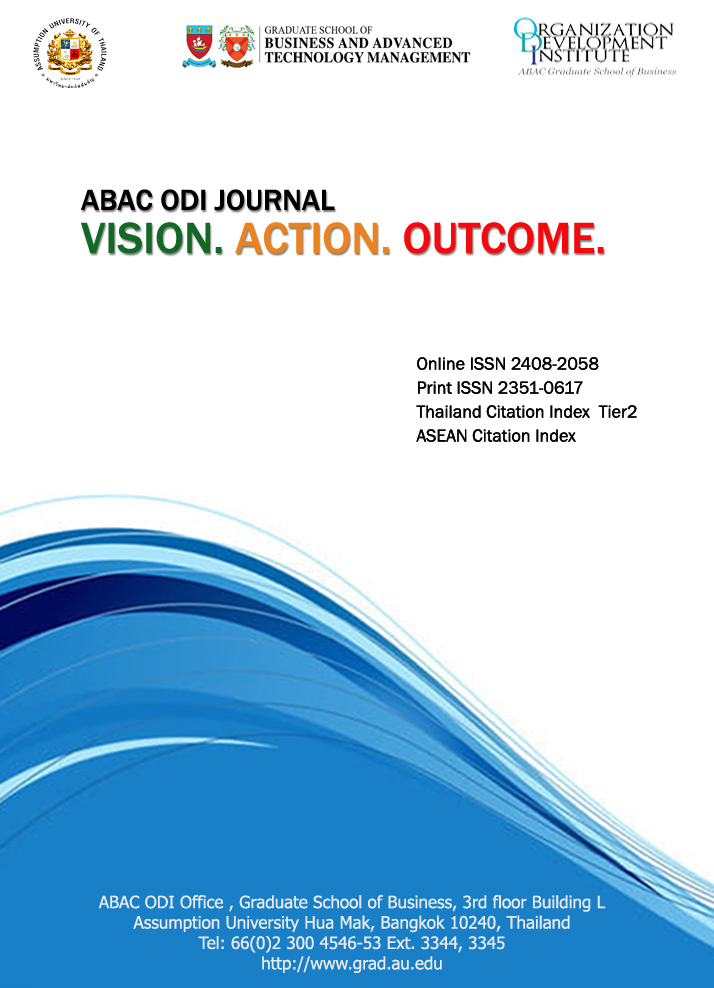Changing Teacher's Teaching Behavior to Improve Classroom Teaching Effectiveness Through ODI(Organization Development Interventions) An Action Research at College of International Business (CIB), in Zhejiang Yuexiu University of Foreign Languages (ZYUFL), in China
DOI:
https://doi.org/10.14456/abacodijournal.2021.1Abstract
Based on the analysis and intervention of CIB in ZYUFL teachers' teaching behavior, this paper aims to improve the classroom teaching effectiveness, including teachers' teaching outcome and students' learning outcome. First, it designed an interview outline for the research topic with business schoolteacher before the formal formulation of the intervention program. Second, we have consulted the contents about the effect of classroom teaching in colleges and universities at home and abroad, and fully understood the importance of improving the quality of classroom teaching. Third, the paper reviews about the main variables such as teacher's teaching behavior and teaching effectiveness. It puts forward the theoretical framework, conceptual frame of this study work and action research framework. It uses 360-degree evaluation method to evaluate teachers' teaching behavior and teaching effectiveness. Fourth, the intervention program aimed at changing teachers' teaching attitude, teaching content and teaching methods is designed, and the concrete method of data collection is formulated. Fifth, through ODI for 7 months, the data has been collected before and after the intervention. It uses EXCEL and SPSS to compare and analyze the data. Through mean analysis, teachers' teaching behavior and teaching effectiveness have been significantly improved. Through paired sample analysis with the control group, the change of teachers' teaching behavior is significant, but the evaluation gap of teaching effectiveness, especially the students' learning outcome is not obvious. Finally, the relevant research is prospected and suggested, and the short comings of this research are pointed out.
References
ACU (2017). Teaching criteria and standards framework. Retrieved from:
https://policies.acu.edu.au/learning and teaching/teaching criteria and standards framework.
Aliberas, J., Rufina Gutiérrez, & Mercè Izquierdo. (2019). Identifying changes in a student’s mental models and stimulating intrinsic motivation for learning during a dialogue regulated by the teach back technique: a case study. Research in Science Education, (6), 1-29.
Bryson, A., Forth, J., & Kirby, S. (2005). High‐involvement management practices, trade union representation and workplace performance in Britain. Scottish Journal of Political Economy, 52(3), 41.
CHEA (2018). Accreditation & recognition. Retrieved from https://www.chea.org/about- accreditation.
Chickering, A. W., & Gamson, Z. F. (1989). Seven principles for good practice in undergraduate education. Biochemical Education, 17(3), 140-141
CIHE (2018). Evaluation Manual 2016. Retrieved from:
https://cihe.neasc.org/cihe-publications/evaluation-manual-2016
Clark, C. M. & Peterson, P. L. (1986). Teachers’ thought process: In Wittrock, M. C. &Peterson, P. L. handbook of research on teaching (3rd edition). New York, Macmillan.
Dagal, A. B. R. (2017). A developmental study on evaluating the performance of preschool education institution teachers with 360degree feedback. Journal of Education & Training Studies, 5(6), 220.
David C. B. & Robert C. C. (2019). Handbook of educational psychology. New York: Simon & Schuster Macmillan.
Huang, F. T. (2017). What is the undergraduate education of the world's top universities?. Higher Education Studies, 8, 1-9.
Islami, X., Mulolli, E., & Mustafa, N. (2018). Using management by objectives as a performance appraisal tool for employee satisfaction. Future Business Journal, 4(1), 94-108.
Jin, W., Yang, J., Yang, X. Y. (2015). Changes in the quality assurance mechanism of higher education in Australia. Development and Assessment of higher Education, 02, 105-110.
Kaycheng, S. (2017). Fostering student creativity through teacher behaviors. Thinking Skills & Creativity, 23, 58-66.
Kimberly M. S., David, W., Nyaradzo, M.(2016). What drives student engagement: Is it learning space, instructor behavior, or teaching philosophy?. Journal of Learning Spaces, 5, 2.
Kratz, H.E. (1896). Characteristics of the best teachers as recognized by children. Journal of Genetic Psychology, 3, 413-418.
Lawler III, E. (1986). High-involvement management. San Francisco. USA: Jossey-Bass.
Reilly. B. O. (1994). 360 feedback can change your life. Fortune, 93-100.
Report of the Eighteenth National Congress (2017, October 16). Retrieved from: http://language.chinadaily.com.cn/19thcpcnationalcongress/2017-10/16/content_32684880.htm.
Richard James, Chen, Y. C. (2004). Experience in assessment and improvement of undergraduate education in Australia. Fudan Education Forum, 01: 79 -84.
Richardson, J. (2018). Using controversy as a teaching tool: an interview with diana hess. Phi Delta Kappan, 99(4), 15-20.
Shi, Y. D. (2016). Reform and development of higher education in Japan since the 21st century: interview with Maruyama, director of research and development center for higher education, Hiroshima University, Japan. World Education Information, 29 (13), 3 - 8.
Some Opinions of the Ministry of Education on Improving the Quality of Higher Education in an All-round Way (2017, September 28). Retrieved from:
http://jwc.ncu.edu.cn/zjcd/xgwj/jybwj/40866.htm.
Song, Q. Q. (2007). The meaning and characteristics of effective teaching. Educational Development Research, 1, 39 - 42.
Stapleton, P. (2018). Avoiding cognitive biases: promoting good decision making in research methods courses. Teaching in Higher Education, 1-9.
Sun, Y, R. (2006). Reflections on the performance appraisal of college teachers. Higher Education and academic Research, 3, 60-63.
TEQSA. (2015). A risk and standards-based approach to quality assurance in Australia's diverse higher education sector. Australian Government Tertiary Education Quality & Standards Agency.
The Association of ASEAN Universities (2009). Zhang, J. X. translated. ASEAN University alliance quality assurance guidelines implementation manual. Kunming, China: Yunnan people's Publishing House.
The University of Western Australia (2016). Human resources teaching criteria. Retrieved from:
http:// www.hr.uwa.edu.au/working/academic/teaching/teaching-criteria.
Thomas G. Cummings, Christopher G. Worley (2009). Organization development and change (9th ed.). OH, South - Western College Publishing.
Thomas J. S. (2002). Moral leadership-the core of school improvement. Shanghai: China, Shanghai Education Press.
Uygur, J., Stuart, E., Paor, M. D., Wallace, E., & Pawlikowska, T. (2019). A best evidence in medical education systematic review to determine the most effective teaching methods that develop reflection in medical students: BEME Guide no. 51. Medical Teacher, 41(1), 1-14.
Wang, C. S. (2005). A manuscript of teaching theory. China, People's Education Press.
Downloads
Published
Versions
- 2021-06-17 (2)
- 2021-06-17 (1)



